Types of cloud computing
Cloud computing has been expanding for several years, and it will undoubtedly continue to grow enormously in the coming years. In this article, we will explore the different types of cloud computing, and you will learn how each of them offers specific benefits that meet different business needs. Read on to learn more about the options you can use to optimise your IT strategy.

What is cloud computing?
If we look at the definition of cloud computing, we could describe this technology as an on-demand computing service that is accessible via the internet. It encompasses servers, networks, datacentres and software. Instead of purchasing datacentres and physical servers, you pay a subscription to access this technology.
The term “cloud” refers to a network of different computers, where the end user does not necessarily know on which computers their software runs, or how many there are. The most important aspect of cloud computing is that the end user no longer owns the infrastructure or software being used, so they are no longer responsible for its maintenance.
The different types of cloud computing
There are many ways to deploy cloud resources, depending on if you are using a public cloud, private cloud, hybrid cloud or multi-cloud. Below, we will explain the difference:
Public Cloud
Public clouds are the ones most often used by businesses. In a public cloud, the server and storage space are shared with other companies, so companies can work with their software on the same infrastructure.
Access to this cloud is usually via a web browser (such as Chrome or Firefox) and through specific APIs. Public clouds are most commonly used for email programs, online office suite software (such as Microsoft 365), data storage, and test and design environments.
The advantages of a public cloud
✓ Low costs.
✓ Little or no maintenance.
✓ Unlimited scalability and minimal downtime.
✓ The probability of failure is much lower due to the large network of servers.
Private Cloud
A private cloud is a virtual IT infrastructure used by a single company. In this cloud, the user controls the entirety of the security, data and quality of service. The service provider is responsible for the maintenance of the private cloud. Its physical location can be either on the premises of the cloud service provider, or on the user’s premises.
The advantages of a private cloud
✓ Flexibility: The environment can be adapted to the needs and requirements of the customer.
✓ Better security: IT services are not shared with other parties.
✓ Excellent scalability.
Hybrid Cloud
When multiple internal or external clouds are used together, it is called a hybrid cloud. A business might, for example, choose to combine an on-premises infrastructure with private and public clouds to harness the benefits of both.
Resources that require a low level of security can be hosted in the public cloud, while data or programs that are critical to business operations can be hosted in a private cloud or an on-premises environment.
The advantages of a hybrid cloud
✓ A customer can easily migrate resources between different types of cloud computing.
✓ This migration can be done gradually and in stages.
✓ Cost-effective option, as public and private solutions can be combined as needed.
Multi-Cloud
The multi-cloud is a deployment model for cloud computing that allows companies to offer application services across multiple private and public clouds. These services are a combination of multiple cloud providers, multiple cloud accounts, multiple cloud availability zones, or multiple cloud regions/locations.
Sound complicated? Here is an example that should help you:
Within your company, you have a private cloud. On this private cloud, you host your critical internal applications, such as your company’s private file server (IaaS) and a custom-developed software application (PaaS). These private cloud resources are reserved exclusively for your company’s use and offer enhanced control and security.
In this scenario, you use a combination of public and private cloud services to meet the different needs of your business. This setup, where you use multiple cloud providers for different purposes, is what we mean by multi-cloud.
The advantages of a multi-cloud
✓ Greater reliability: a multi-cloud ensures high availability by spreading services across multiple cloud providers, minimising the risk of downtime.
✓ Flexibility: you can choose the cloud providers that are best suited to your work, optimising costs and performance.
✓ Less risk: a multi-cloud strategy reduces reliance on a single provider, mitigating the impact of any outages or service interruptions.
Cloud services
There are three categories of cloud computing services: infrastructure as a service (IaaS), platform as a service (PaaS), and software as a service (SaaS). We will explain this in more detail below:
Infrastructure-as-a-Service (IaaS)
This type of infrastructure is considered the main cloud computing service. It is delivered through virtual solutions or through hardware integration. The IaaS includes servers, networks and storage capacity.
The advantage is that the end user is free to choose the type of infrastructure they want to work with, but they will be responsible for its configuration and maintenance. This means it’s very important to have the technical knowledge within your company so you can take care of it yourself.
PaaS (Platform as a Service)
With this kind of service, the customer no longer has to manage the underlying infrastructure. This means they can focus on deploying and managing their applications. One of the main advantages for the user is increased efficiency, as they do not have to worry about resource acquisition, capacity programming or software maintenance.
Often, developers are involved in using PaaS services, as they require a programming language such as Python, Java, or .NET to clearly configure certain features. The downside is that, in some cases, the customer cannot choose the operating system.
SaaS (Software as a Service)
As part of software-as-a-service, an IT service provider delivers applications to the end user “in the cloud.” The possibilities are vast, with CRMs, email clients and marketing software all included.
With software-as-a-service, the provider has full control over the application. In many cases, however, it is the user (or a third-party provider) who manages the service. They can then manage the application functionally and integrate their own solutions.
Generally, SaaS can be used via a web browser on a computer. Unlike traditional client software, they tend to use modern technologies such as Ajax and HTML5 to achieve similar or better interactive functionality than traditional client software. Many of these applications can be easily used from a mobile device such as a tablet or smartphone.
Edge computing and cloud computing: a synergy for better data processing
Edge computing and cloud computing are two technologies that work together to optimise your data processing. Edge computing allows calculations to be performed close to data sources to achieve low latency and real-time data processing. This approach is therefore ideal for technologies such as self-driving vehicles.
Cloud computing, on the other hand, excels at handling big data processing and complex calculations. Together, these two technologies create a powerful ecosystem in which connected devices pre-process data locally before sending valuable insights to the cloud for deeper analysis and long-term storage.
Our cloud computing solutions
At OVHcloud, we understand that your business needs reliable, scalable and cost-effective cloud solutions. This is why we offer several types of cloud computing, adapted to your needs. With our cloud computing services, we take care of the technical aspects of each project, while you can focus on what matters most: innovation and business growth.

IaaS
Full control and flexibility: OVHcloud offers a solution that provides you with virtualised computing resources, including virtual machines (VMs), storage, and network components. You get full control over your infrastructure without having to manage any physical hardware.
Use cases: Our IaaSs are ideal for development and test environments, web hosting, disaster recovery, and running virtualised tasks. You can increase or decrease resources as needed and only pay for what you use.

PaaS
Accelerate your application development: our solution allows your developers to focus solely on creating and deploying your programs. Make use of our tools and services specially designed for software development, database management and integration.
Use cases: our PaaS solutions are perfect for developers who want to simplify their software development. Use this service to build web and mobile applications, microservices, and APIs. Take advantage of features such as auto-scaling and CI/CD (Continuous Integration and Continuous Deployment).

SaaS
Simplify software accessibility: the SaaS model offered by OVHcloud allows you to deliver applications directly to your users via the internet, on a subscription basis. No need to install or maintain programs – you can access your favourite tools via a web browser.
Use cases: SaaSs are versatile and meet a wide range of business needs, such as email, collaboration tools, CRMs, and other management tools. Our services make them easier to use and more cost-effective.
FAQs
What are the three types of cloud computing?
There are three types of cloud computing: SaaS, PaaS and IaaS.
What is IaaS, PaaS and SaaS?
IaaS is a cloud computing model where you only pay for the use of services such as storage, networking and virtualisation. PaaS provides tools over the internet, allowing users to focus on creating and managing software without having to worry about the underlying infrastructure. Finally, SaaS offers software that is directly accessible via the internet or provided by a third party, eliminating the need for local installation or maintenance.
Which cloud should I choose?
To choose the right cloud, you’ll need to consider your company’s specific needs. IaaS allows you to maintain complete control over your infrastructure, while PaaS simplifies your development process. Saas allows you to work with your programs with total peace of mind.
Which type of cloud is most secure?
The most secure cloud depends on several factors, such as the kind of data and applications you want to host, the management measures you want to implement, and the requirements of your industry. Private clouds are considered safer than public clouds, as they are specifically set up for a single company and offer better control over security measures.